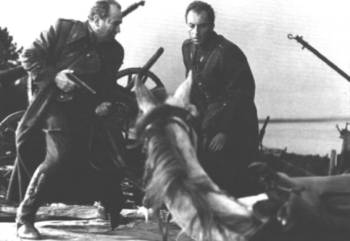 | ||||||||||
Lotna
 fot: Renata Pajchel |
The plot of Lotna is simple and clear: it is September 1939, the beginning of World War II. A beautiful Arab horse from a magnate's stables falls accidentally into the hands of a cavalry Captain in command of a squadron and immediately becomes the object of desire for others: the Lieutenant, the Officer Cadet, and finally of the squadron leader, Sergeant Major Laton. However, the war takes the lives of both the Captain and the Officer Cadet. When, finally, it is the Lieutenant's turn to ride Lotna, the Sergeant Major abducts the horse and flees amidst the abandoned supply wagons and equipment of the retreating army. Unfortunately he and the horse take a bad fall and Lotna breaks her leg. The Lieutenant uses his pistol to put the horse out of its misery. So ends the legend and the curtain falls on the last chapter of the history of Polish cavalry.
Andrzej Wajda
Reviews
If I correctly guess Wajda's intentions, his new film is supposed to be a kind of artistic conclusion to the age of Polish romanticism, which reached its bloody climax in September 1939. This was to be a film evoking, perhaps for the last time, the typically Polish poetry of horse and sabre. In form, however, was not intended to be a lyric, but a critical poem, bound together by bitterness and, at times, by sarcasm. But this is not what actually happened. In the dialogue between critic and poet, the poet wins. In the debate between the rationalist and the romantic, the romantic emerges triumphant. The researcher of historical paraphernalia has become their museum curator. Lotna became a film dedicated to the poetry of props; it grieves me to say it it is a poetry of form, rhythm and colour rather than of content.
Stanislaw Grzelecki
"Zycie Warszawy", Warsaw, 8 October, 1959
This film lives in the mind of the viewer . For example, since the premiere my opinion of Lotna has undergone a change in its favour. It seems to me that Wajda, essentially a cold creative artist, is looking for ôhot" subjects which give him the opportunity to introduce various "oddities." But because he is very talented, these grow into artistic problems, and begin to obscure issues which the artist himself cannot control.(...)
Is Lotna, then, a failed effort? It is difficult to say. In art, the most interesting works are often some kinds of failures. For me, the conflict between the artist and his creative material exemplified by in Lotna is more interesting than the conflict within the work itself.
Aleksander Jackiewicz
"Film", Warsaw, 1 November, 1959
This is probably a good time to remember the famous proverb, according to which no one is a prophet in his own country, Wajda has never enjoyed the same success with the Polish audience as he has in the West.(...)
The film is a crucial work in the baroque style, worthy of a place in the tiny pantheon of baroque films, such as The Empress by von Sternberg, Lola Montes and The Trial by Welles, Eight and a Half, and several others. From the very beginning the plaster statues, which populate a park aflame with autumn hues, and the huge mirrors in the abandoned palace, transport us into a baroque universe. Catches? Yes, certainly, especially explicit in the use of certain typical elements. The inventiveness of the filmmaker, however, doesn't stop to amaze us particularly in his masterful handling of colour, he has found the means to create visual enchantment for which I can find no precedent.
Marcel Martin
"Cinéma 65", Paris, April, 1965
Oscar | Films | Theatre | Why Japan?
Favourites | Pictures gallery | About Wajda | Bibliography
Main Page | Search | Wersja polska
Copyright © 2000 Proszynski i S-ka SA. All rights reserved